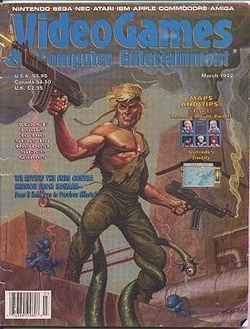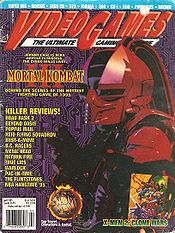
Video Games & Computer Entertainment
Encyclopedia

Video game console
A video game console is an interactive entertainment computer or customized computer system that produces a video display signal which can be used with a display device to display a video game...
and arcades
Arcade game
An arcade game is a coin-operated entertainment machine, usually installed in public businesses such as restaurants, bars, and amusement arcades. Most arcade games are video games, pinball machines, electro-mechanical games, redemption games, and merchandisers...
. It was published by LFP, Inc
Larry Flynt Publications
Larry Flynt Publications, or LFP, Inc., runs the adult entertainment empire founded by Larry Flynt. Founded in 1976, two years after Flynt began publishing Hustler magazine, LFP was originally to serve as the parent company of this magazine....
from the late 1980s until the mid-1990s.
Offering game reviews, previews, game strategies and cheat codes as well as coverage of the general industry, VG&CE was also one of the first magazines to cover both home console and computer games. The magazine gave out annual awards in a variety of categories, divided between the best of home video games and computer video games. The magazine was known for its artwork, created by Alan Hunter and other freelance artists
Freelancer
A freelancer, freelance worker, or freelance is somebody who is self-employed and is not committed to a particular employer long term. These workers are often represented by a company or an agency that resells their labor and that of others to its clients with or without project management and...
.
VG&CE was started at LFP by Lee Pappas (listed as Publisher), with Andy Eddy
Andy Eddy
Andy Eddy is an American video game journalist and critic. He currently resides in Redwood City, California.- Biography :Eddy was the executive editor of VideoGames & Computer Entertainment in the late 80s and early 90s, followed by tenure as a senior editor at GamePro magazine...
as Executive Editor. (Eddy was a freelance contributor to the first issue of the magazine, which had the cover date of “December 1988,” just before relocating to California in September 1988 to become its editor before the first issue hit the streets. During Eddy's tenure at the magazine, there was no one listed as Editor in Chief, simply due to odd staff-titling decisions. For all intents and purposes, Eddy was the magazine's Editor in Chief.) Contributors included Arnie Katz and Bill “The Game Doctor” Kunkel, co-founders of the first video-game magazine, Electronic Games
Electronic Games
Electronic Games was the first video game magazine published in the United States and ran from 1981 to 1994. It was co-founded by Arnie Katz and Bill Kunkel, and is unrelated to the subsequent Electronic Gaming Monthly.-External links:* *...
. Tips & Tricks
Tips & Tricks
Tips & Tricks is an American video game magazine published by Larry Flynt Publications . For most of its existence, the publication was devoted almost exclusively to strategies and codes for popular video games...
Editor in Chief Chris Bieniek was an associate editor at VG&CE. Computer Player Editor in Chief Mike Davila was an associate editor and later executive editor at VG&CE. Knights of Xentar
Knights of Xentar
Knights of Xentar is an eroge role-playing video game released for PC DOS in North America in 1995 by Megatech Software. It is also known as Dragon Knight III in Japan and is part of the Dragon Knight series of games created by Japanese game developer ELF, who originally released the game for the...
writer David Moskowitz was also an associate editor at VG&CE during the Eddy/Davila/Bieniek tenure.
“VideoGames” Era

GamePro
GamePro Media was a United States gaming media company publishing online and print content on the video game industry, video game hardware, and video game software developed for a video game console , a computer, and/or a mobile device . GamePro Media properties include GamePro magazine and...
, the magazine was made more kid-friendly with vibrant colors and issues often featured a videogame cheat printed on the cover, labelled as a “free code” (this ended in late 1994). In this time period, Mortal Kombat
Mortal Kombat (video game)
Mortal Kombat is a 1992 fighting-game developed and published by Midway for arcades. In 1993, home versions were released by Acclaim Entertainment. Released in the Fall of 1994, the Microsoft Windows 3.1x version was released by Activision Interactive. It is the first title in the Mortal Kombat...
and its first two sequels were often featured on the cover, and a listing of Fatalities and special moves lists were basically a monthly feature. In the July 1993 issue of VideoGames, Mortal Kombat co-creators Ed Boon
Ed Boon
Edward J. Boon is an American video game programmer who had been employed for over 15 years at Midway. He now works for Warner Bros...
and John Tobias
John Tobias
John Tobias is an American comic book artist, graphic designer and video game designer. Along with Ed Boon he is one of the creators of the groundbreaking Mortal Kombat fighting game series....
first told the specific requirements to find the hidden character Reptile
Reptile (Mortal Kombat)
Reptile is a fictional character in the Mortal Kombat series of video games. Created for Midway Games by John Tobias and Ed Boon, Reptile debuted in Mortal Kombat as a hidden boss and appeared in subsequent titles as a playable character. The character has also appeared on various merchandise,...
. http://www.mobygames.com/game/mortal-kombat/trivia
For much of this era, Chris Gore
Chris Gore
Christopher Patrick "Chris" Gore is an acclaimed speaker and writer on the topic of independent film.Gore was born September 5, 1965 in Big Rapids, Michigan. He is the main writer and the founder of Film Threat, a project dedicated to covering independent and underground movies which he started in...
was editor-in-chief, and had a monthly news and gossip column titled “The Gore Score.”
The magazine ended publication in late 1996, when Ziff-Davis bought VideoGames from LFP and folded the brand.
Spin-off magazines
VG&CE spun off several other notable video-game magazines, including:- TurboPlay Magazine (June/July 1990-August/September 1992), a bi-monthly magazine dedicated to covering TurboGrafx-16TurboGrafx-16TurboGrafx-16, fully titled as TurboGrafx-16 Entertainment SuperSystem and known in Japan as the , is a video game console developed by Hudson Soft and NEC, released in Japan on October 30, 1987, and in North America on August 29, 1989....
hardware and software. - Tips & TricksTips & TricksTips & Tricks is an American video game magazine published by Larry Flynt Publications . For most of its existence, the publication was devoted almost exclusively to strategies and codes for popular video games...
, a game magazine dedicated to game strategies and cheat codes. The magazine concept was spun out of the “Easter Egg Hunt” and “Tips & Tricks” sections in VG&CE, which offered extensive codes and cheats for video games, as well as the “walkthrough” strategies that VG&CE also provided.

